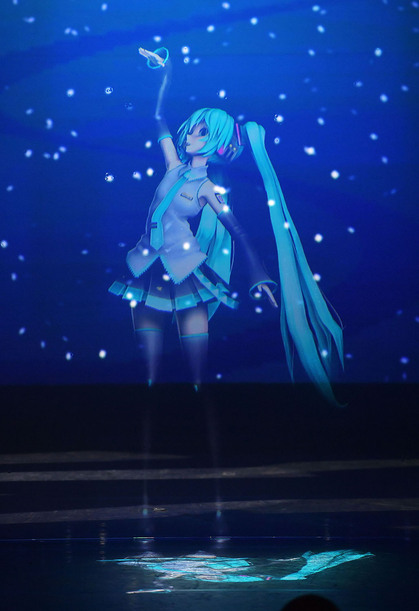
R
E
V N
E
X
T
Still Be Here (2017) performance at the Barbican, London, 2017, by Mari Matsutoya, Laurel Halo, Darren Johnston, LaTurbo Avedon and Martin Sulzer. Courtesy Barbican.
There is a tension in the language that flows around and through Hatsune Miku. The phenomenally popular Japanese virtual popstar, created in August 2007, is referred to simultaneously as “she” and as the product and property of various corporations and creators. The Vocaloid software that synthesizes her voice was developed by Yamaha, whose synthesizer range’s turquoise color scheme also informed her image as designed by manga artist Kei Garō, and her dance routines are developed with MikuMikuDance, a piece of custom freeware. In a turn redolent of sci-fi cinema, her developers, Crypton Future Media, consider her the first of a “series”; her name translates to “first sound from the future.”
There is also a human element, or the implication of one, in both Miku’s persona and activity. Kawaii (“cute”) and often sexualized, she is quoted as being 16 years old, 158 centimeters tall, and weighing 42 kilograms. The dissonance between her commodification and intimated humanity is compounded by her status as a “collaboratively constructed cyber celebrity.” She is at once the object and product of desire.
Miku was originally a software instrument that professional and amateur music producers could use in their creations. As such, over 100,000 songs have been released using her voice and over a million related graphic artworks, all under creative commons and with distribution facilitated by Crypton’s own record label. The only stipulation for use is that the character not be represented derogatorily. First commissioned by Berlin music and arts events CTM festival and Transmediale in 2016, Still Be Here owed its existence and much of its critical content to this freedom.
Somewhere between installation, video essay and performance, the collaborative project was conceived by conceptual artist Mari Matsutoya. It bore many of the hallmarks of a concert: songs, digitally designed backdrops, a light show and of course the Miku “hologram,” but also documentary-style footage and interviews with founders, creators and fans.
All of this was treated in such a way as to stress, and thus reveal the lack of, Miku’s selfhood. The songs, composed by music producer Laurel Halo, were spacious and pensive. Their lyrics were seeded from Miku’s more popular songs, algorithmically scrambled and set to her melodies by Matsutoya. As such, they hinted at a nebulous personality, a product of the randomized will of others, but also an introspective bent in Miku’s many lyricists.
Much of the piece’s affective force was in stripping Miku of this collective will, imbuing “her” with the autonomy such a human pronoun implies, and foregrounding its limitations. Some lyrics—“These hands will never grasp your hands/Both of us accept defeat,” for instance—highlighted her artificiality, subverting her love songs into a tragic mode. When founders and fans spoke, the Miku hologram would turn its back to the audience, crouch down or curl up, and listen as her identity was described and subsumed within the fantasies of others.
Martin Sulzer and LaTurbo Avedon’s digital backdrops reinforced the effect of a pop star enacting an existential crisis on stage. There were collaged screenshots of the software used to create Miku’s avatar, blogged love letters whose doting insistence on her realness only emphasized its inadequacy, and her image, with all but hair and clothes made transparent—resembling the invisible man—superimposed over footage of market produce. Although both were pure commodity, the glistening flesh of fruit and fish superseded hers.
Darren Johnston’s minimal choreography eschewed MikuMikuDance in favor of motion tracking, and like the music was wistful, human, lacking in J-pop ebullience. It emulated the storytelling of traditional Japanese dance in a body whose only stories belong to others, leaving a representation of a character without agency: vulnerable, confined to the limits of a projection, impossibly light in both her declared and existential weight.
All of this culminated in an artwork that was implicitly critical of a phenomenon in which it nonetheless participated. Revealing Miku, her voice and her apparently female “body” as the site of coalescent fantasies was itself the product of a desire and way of seeing. In her lightness, Miku cannot be freed of her creators or her fans without disappearing entirely. She is an instrument of desire.
To read more of ArtAsiaPacific’s articles, visit our Digital Library.






